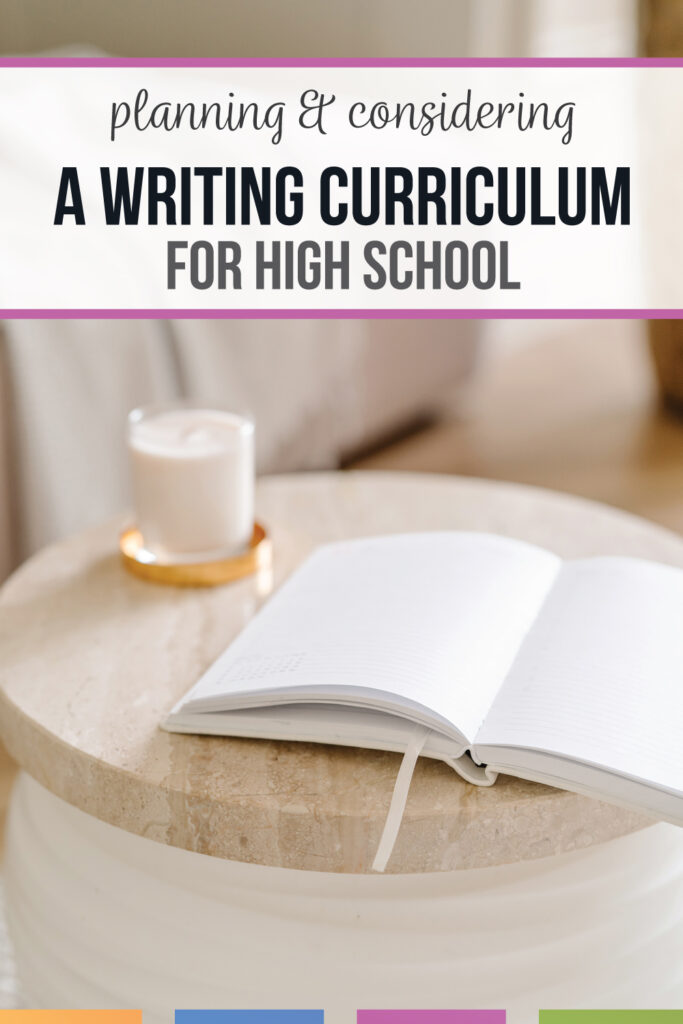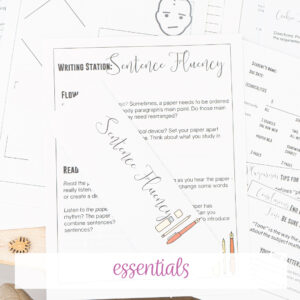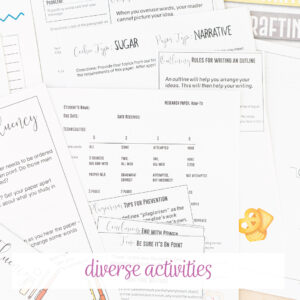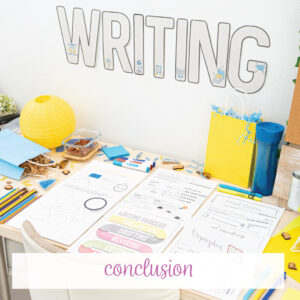In this comprehensive high school writing curriculum guide, I explain necessary components of planning a writing for a year.
Writing is an essential skill that students need to develop in high school. Part of teaching this essential skill is encouraging, inspiring, and mentoring.
However, not all writing curriculums are created equal. A well-structured writing curriculum can help students understand the fundamentals of writing, improve their skills, and explore their creativity.
High School Writing Curriculum: A Comprehensive Guide
Honesty time: I do not suggest one entire curriculum but rather, pieces from several sources. Many tools can get you to meeting standards, encouraging young writers, and working through common struggles. However, as someone who has taught in various capacities for over twenty years, one set curriculum will probably not work. You will need to incorporate pieces of your own to address the learners in front of you and modify it each semester.
Therefore, in this blog post, I’ll explore the components, considerations, and requirements for high school students.
Why are you writing about a high school writing curriculum?
If you have followed me for a few years, you were with me while I finished my second master’s degree, one in English Literature. Now, I teach dual-credit writing courses at my high school in coordination with a local community college. Many of my subscribers teach a similar class for high school credit.
The previous seven years, I taught freshmen and worked with those standards. Therefore, my teaching load focuses on standards for seniors, a shift for me.
As I create and build my high school writing curriculum, these considerations come into play.
Understanding the Essentials of a High School Writing Curriculum
A comprehensive high school writing curriculum will address students’ writing skills and grammatical knowledge. Meeting language skills alongside the writing standards can happen naturally.
A well-rounded high school writing course will also address essential aspects such as argumentative writing (sometimes referenced as persuasive writing), informative, and creative/narrative writing, providing students with a holistic understanding of the writing process.
Here is my teacher’s guide to incorporate all these factors.
Importance of a Structured Approach to Writing
A structured approach to writing is essential in a writing curriculum. In my teaching career, I have taught several semester-long courses like public speaking, creative writing, and English 101. My #1 learned lesson: Have an overarching project that builds community in classes. For public speaking, speakers set goals for public speaking. In creative writing, writers compile a journal with writing prompts.
In a standard writing class, we use images to write about mentor sentences and fun topics. Images help young writers envision their responses, and the images work as a form of scaffolding. An ongoing activity, a habit, allows writers to reflect on their writing process, figurative language use, and sentence structure. Take time to reflect with students.
Diverse Writing Assignments
Instilling excellence in writing skills and grammar instruction is essential for an effective writing curriculum. One research paper and one narrative alongside “drill and kill” grammar will not produce an engaging high school writing curriculum.
A few of my favorite writing assignments for high school:
- Mini-memoirs (narrative standards)
- Response to informational text (an assortment of standards)
- Argumentative RAFT (argumentative standard)
- Researched famous events (expository standards)
If you look at the mentor texts (below) and provide excerpts to your classes, you will also create diverse writing assignments from those inspired pieces.
Calendar of Writing
Map out your calendar of dates. No amount of researching and organizing will help us creators of a high school writing curriculum: We must sit down with a calendar.
My high school writing curriculum contains two large-ish type assignments, one due about six weeks into the semester and another at about fourteen weeks. I space them out so that students understand my expectations and feedback, so that we have worked through our standards together, and so that large assignments are not due when students are already overwhelmed. Spacing out assignments in this manner also provides me time to provide meaningful feedback.
If you are interested in looking at my outline for a creative writing course, you can make a copy on Canva (for free).
Grammar Excellence
If you have floated around my blog for a bit, you’ll realize that my preference is not to teach grammar with worksheets. A grammar workbook and worksheets have their place, sure. But once classes understand the basics of language, I branch into additional resources.
For instance, with my high school grammar activities, students use interactive pieces to practice punctuations, to add types of clauses to sentences, and to experiment with difficult concepts. The pieces allow writers to take their own writing and implement lessons. In doing so, they are experimenting with language.
Another addition to any writing program will be addressing grammatical errors. My suggestion is to assign paragraph writing and while grading, note common errors. Then, provide direct instruction and practice correcting the errors.
Any grammar curriculum will connect grammar to writing. One of my goals is to approach language in a positive way so that my brave writers feel empowered instead of crushed by grammar rules.
Meeting Standards with Writing
Writing standards define the expectations for what students should be able to do at each grade level. These standards aim to develop clarity, coherence, and effective communication through writing.
However, meeting these standards can sometimes be a challenge for both students and teachers. Below, I explain what helps me as my students and I work to meet writing standards.
Importance of Writing Standards
Writing standards are guidelines that outline the skills and knowledge students should acquire in writing. They provide a common framework for teaching writing skills, ensuring consistency across classrooms and grade levels.
Be prepared to breakdown standards with students in sensible ways. For instance, in my creative writing activities, I break down pieces like implementing pacing and external conflicts into smaller lessons. With those smaller activities, we can dive deep into the standards.
Overall, writing standards promote clarity, coherence, and effective communication, which are essential skills in the 21st century.
Implementation of Standards
The more you build your writing curriculum, the more engrained and natural the standards will be.
To start, align writing activities with specific standards. By doing so, you ensure that the writing skills targeted are directly tied to the standards. This alignment helps reinforce the skills and knowledge necessary for students to meet the standards effectively.
Additionally, incorporating a wide range of writing skills into lesson plans allows you to address multiple standards simultaneously, providing a comprehensive writing instruction experience for students. In the example above, pacing and external conflicts will occur in smaller activities and then implemented into larger one.
Don’t fear breaking down a standard with students. (Some teachers call this process “unpacking the standards”). The more you discuss writing expectations that derive from the standards, the more meaningful discussions you and your students will have.
Considering mentor texts.
Mentor texts are simply example texts that work well for providing example of structure, vocabulary, language use, and any other piece of writing. Below, I have included books from which I pull pieces. Included are explanations of ways I use the excerpts.
Plus, university writing courses often use excerpts, so using them is a great way to prepare classes. If you read a publication like the New York Times, keep your eyes open to pieces you can add.
All of these affiliate links will take you to Amazon. You can read my disclosures about affiliate links.
The 57 Bus
This book might be the most loaned book from my classroom library. Dashka Slater is a journalist who wrote The 57 Bus, a story told from two perspectives of what became a hate crime.
Five Little Indians
Michelle Good’s novel portrays the lives of residential school survivors. The uses for Five Little Indians is diverse. Dialogue, setting, and pacing shine through in this story.
The Forgotten Girls
Monica Potts’ memoir weaves research into a narrative. The story covers rural women and their limited options. When older students write narratives, I encourage them to add research and use Potts’ memoir as a mentor text.
The Sun Does Shine
I’ve written about The Sun Does Shine before. Pieces from Anthony Ray Hinton’s story have been in my American literature class too. For a writing class, chapter two, “All American,” works well for modeling background and flashback.
Caste
Chapter twenty-seven, “The Symbols of Caste” works as a model for comparing two situations. Isabel Wilkerson compares America’s response to slavery to Germany’s response to the Holocaust. Her pacing and transitions serve as strong examples.
Slavery by Another Name
Douglas A. Blackmon’s book provides examples of incorporating primary sources into research. The end to the chapter, “New South Rising” has a short piece to analyze with writers.
Dreamland
The chapter, “Took Over the OxyContin Belt” serves as a mentor text for narrative nonfiction. From its hook to its powerful concluding paragraph, this short chapter helps me to model narratives.
Patient H.M.
Patient H. M. is about lobotomies, written by the grandson of a famous doctor who performed them decades ago. Luke Dittrich incorporates interviews into research. You can also use excerpts to model writing about delicate topics.
Excerpts from larger books provide authentic texts for young writers and if they are interested, you can loan them the book. Incorporating mentor texts into your high school writing curriculum provides young writers with inspiration and examples.
For those readers who are designing a homeschool writing curriculum, you can ask your local librarian for suggestions regarding books of varying genres.
Conclusion
In conclusion, a high school writing curriculum should provide a structured approach to writing that covers key components such as grammar, vocabulary, and essay writing. It should also offer options that cater to different learning styles and preferences.
While most writing curriculums have their merits, it is important to incorporate creative elements to engage and inspire today’s high schoolers with your own touch. By tailoring the curriculum to your student’s needs and interests, you can make the learning experience more enjoyable and effective.
Replace a student workbook with excerpts, webinars, and audio pieces to diversity the curriculum.
Remember, the goal is to equip them with the necessary skills to express themselves confidently and effectively in various writing formats. You can see details of my high school writing curriculum as a foundation for your classes.













